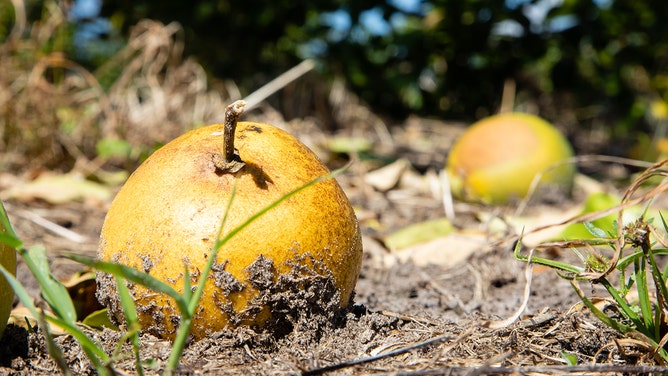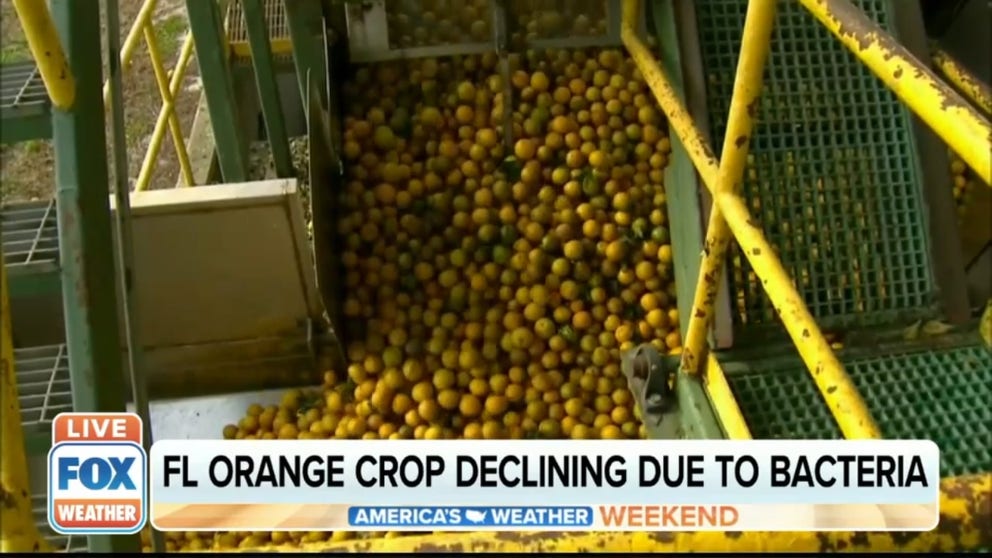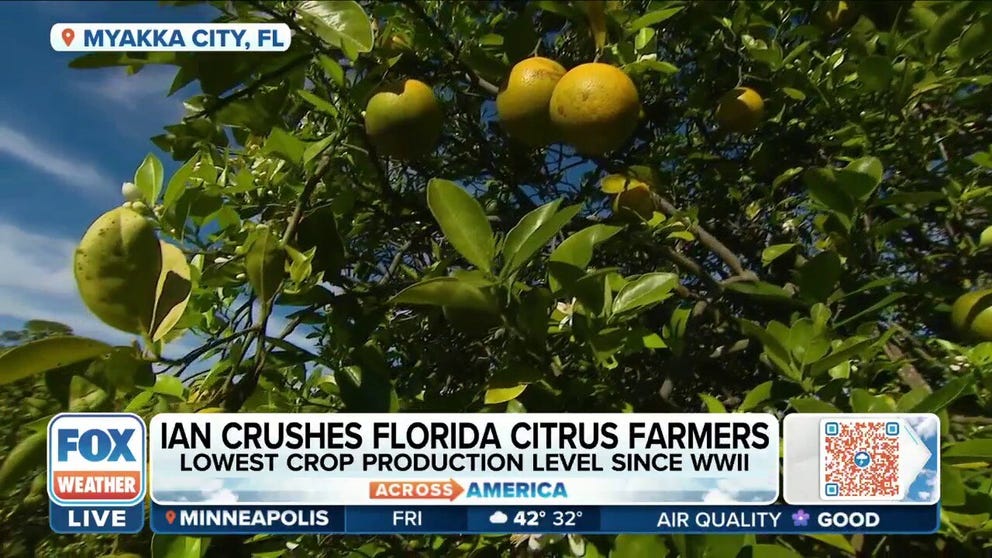Hurricane Ian crushes Florida citrus farmers already facing worst crop since World War II
Already challenged with a citrus crop yield at the lowest production level since World War II, growers have been dealt another blow after Hurricane Ian passed over the heart of the state’s citrus footprint that spans more than 340,000 acres.
Florida orange production sees smallest crop in more than 75 years
The Department of Agriculture says Florida is on pace to produce 44.5 million boxes of oranges during the current season, which is the smallest crop in more than 75 years.
WINDERMERE, Fla. – The Florida citrus industry is bruised from years of hardships, but the farmers cultivating America’s love of the Sunshine State's orange juice are a resilient bunch.
Already challenged with a citrus crop yield at the lowest production level since World War II, growers were dealth another blow after Hurricane Ian passed over the heart of the state’s citrus footprint spanning more than 340,000 acres.
About 57% of those farmlands saw winds above 74 mph, according to the U.S. Department of Agriculture. Nearly all witnessed winds above 58 mph.
Ian's sour note
"We're going to keep on fighting until we can't fight anymore," said fourth-generation citrus farmer Glenn Beck who knows a bushel or two about growing oranges.
His family has been in the industry for more than 100 years. Beck Brothers Citrus is now nurturing more than 6,500 acres spanning six counties in central and south-central Florida.

Fallen oranges and damaged trees following Hurricane Ian at a grove in Charlotte County, Florida, on Friday, Oct. 7, 2022.
(Tristan Wheelock/Bloomberg / Getty Images)
On Beck's farmland in Lake County, the damage was minimal, with very little fruit on the ground. Drive south and southwest, however, and he said the injury to his crops gets progressively worse. It is to the point that, in some cases, 100% of the fruit was lost along with a high rate of tree loss.
"Industry-wide, it was catastrophic in an industry that has been crippled by disease," Beck said.
Ian major setback for the citrus farmer industry
Florida Citrus Mutual CEO Matt Joyner says it will take years for crops to recover after The Sunshine State sees its smallest orange production in 75 years.
For decades, growers have been battling citrus greening caused by an invasive pest called the Asian citrus psyllid.
BACTERIAL DISEASE DROPS FLORIDA'S ORANGE CROP TO SMALLEST IN 75 YEARS
Florida is also no stranger to hurricanes and freezes. Many farmers, like Beck, were still recovering from Hurricane Irma in 2017, which inflicted nearly $800 million in initial damages to the citrus industry in the state and destroyed about 60% of the crop yield.

Fallen oranges on the ground following Hurricane Ian at the Mixon Fruit Farms orchard in Bradenton, Florida, on Wednesday, Oct. 5, 2022. Initial damage estimates to Florida groves from Hurricane Ian pointed to a significant crop loss from high winds, pushing orange juice futures rose in New York to the highest in almost six years.
(Tristan Wheelock/Bloomberg / Getty Images)
Despite all the obstacles put before Florida citrus farmers, they feel driven to continue as long as possible.
"It's just so deeply ingrained in the ones who have done it for a living that no one wants to give it up," Beck said. "This is what we've always done, and this is our passion to stay in farming."
Economics now dictates Beck’s decisions in the recovery process as he is forced to pick and choose blocks of damaged farmland to replant following Ian as part of a gradual rebuilding process.
"It certainly went away much quicker than we can bring it back," Beck said.
Squeeze on OJ futures
The USDA released their initial citrus crop forecast for the 2022-23 season on Wednesday, estimating 28 million boxes, which is down 32% from last season's final utilization. The numbers are staggering compared to the 244 million boxes produced during the industry’s peak in 1998.
Mark Hudson, with the USDA's National Agricultural Statistics Service, said the impact of Ian on Florida’s citrus crops is currently unknown as their survey measurements were performed and completed prior to the arrival of the hurricane and no consideration was given to the storm's impact. The next citrus forecast will be in December when the full impact of the storm may be reflected.
Analysts also believe it is too early to tell if the price of the state's signature crop will impact consumers' wallets at the store. However, if it is any indication, orange juice futures rose in New York to the highest in almost six years immediately following Ian.
"Looking back to 2017, when Hurricane Irma hit the state, consumers saw the price of orange juice rise after growers lost up to 70% of their crops. That’s a big deal when Florida makes up nearly 60% of the nation’s total citrus acres," Everstream Analytics' chief meteorologist Jon Davis said.
FLORIDA’S CITRUS INDUSTRY STRUGGLES IN WAKE OF SEVERE WEATHER EVENTS AND DISEASE
Florida Agriculture Commissioner Nikki Fried said she was heartbroken to see such an iconic Florida industry hurting right now.
"This year will be tough, no one is disputing that, but I believe in the tenacity and passion of our citrus industry professionals to come back stronger than ever," she said following the release of the USDA crop forecast.
Rebuilding the industry
Growers were optimistic about the season before they were hit by Ian, according to Executive Vice President and CEO of Florida Citrus Mutual Matt Joyner. He said farmers were just getting back on their feet to start ramping up production in the state's $6.7-billion industry from many of the new trees that had been planted five years ago.
Horticultural techniques, along with advances in breeding and tools through research also offered new varieties more tolerant to greening to help rebuild the industry.
"While we are certainly greatly diminished from where we have been in the past, we still have a lot of acreage under cultivation in citrus," said Joyner. "We've just got to move forward and get past a lot of these setbacks."
Even though Joyner does not know what the future holds in a foreign supply of juice, he said there's always a danger of increased imports to displace Florida’s commodity. He is confident, however, that people want their domestically produced product.
"We’re one of three states in the union that does what we do, and I'd say we do it better than anybody," Joyner said. "California, Texas and Florida is where your citrus comes from, and your juice comes from Florida."

